Business Environment: Stakeholder Analysis Report - MGT501
VerifiedAdded on 2022/10/14
|16
|4290
|308
Report
AI Summary
This report provides a comprehensive analysis of business stakeholders, focusing on both internal and external groups and their impact on the business environment. It examines the case of Coles-Wesfarmers, identifying key functional areas such as management, marketing, and IT. The report delves into the roles and interests of various stakeholders, including shareholders, customers, employees, suppliers, and government entities. It explores the implications of stakeholder relationships and the level of influence each group holds, utilizing a stakeholder matrix for further analysis. The report also discusses stakeholder differences and dissimilarities, culminating in a conclusion that synthesizes the findings and references relevant literature. The analysis highlights the importance of understanding stakeholder dynamics for effective business operations and long-term sustainability. The report also touches upon the IT infrastructure and the role of the IT manager in the business.
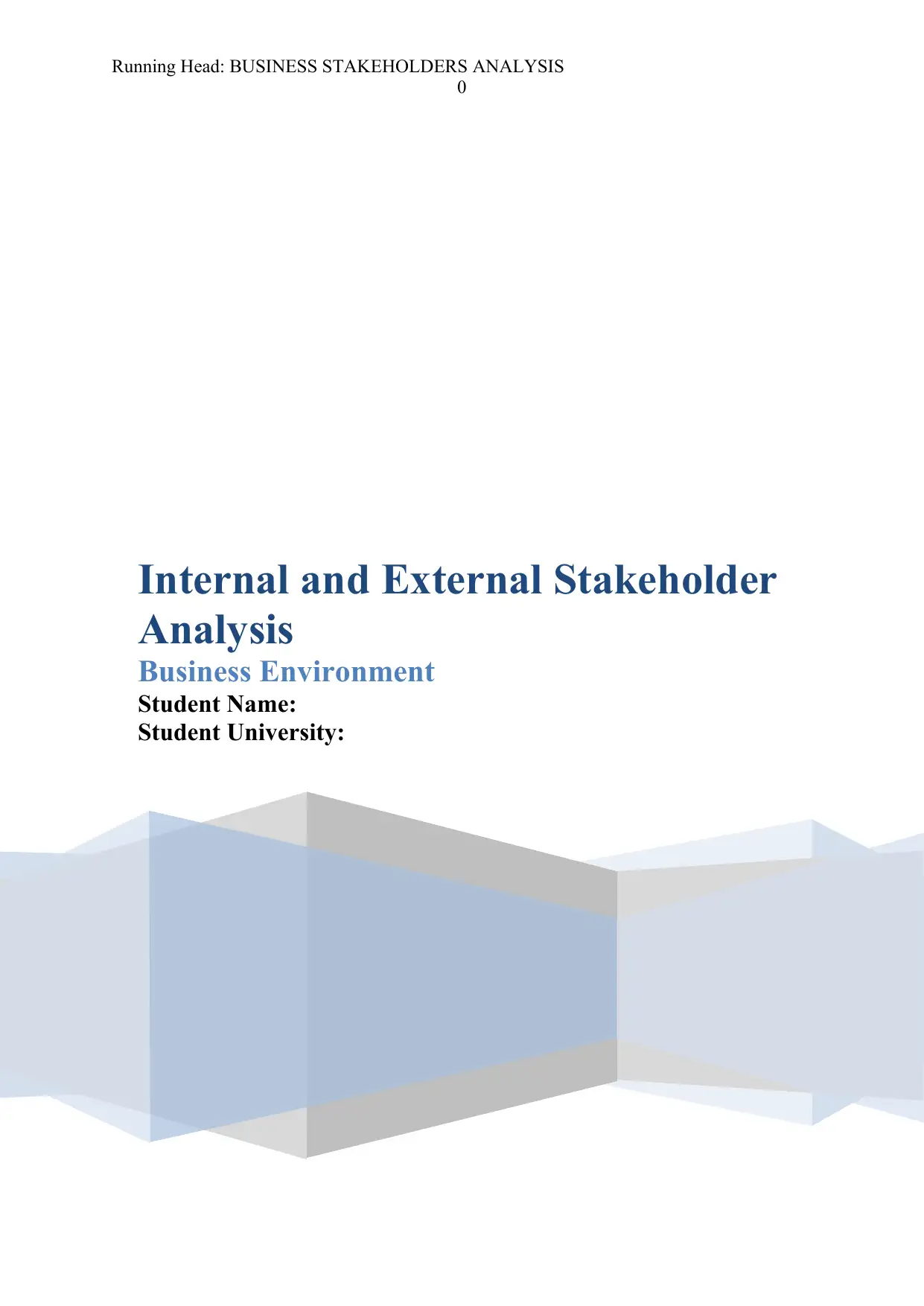
Running Head: BUSINESS STAKEHOLDERS ANALYSIS
0
Internal and External Stakeholder
Analysis
Business Environment
Student Name:
Student University:
0
Internal and External Stakeholder
Analysis
Business Environment
Student Name:
Student University:
Paraphrase This Document
Need a fresh take? Get an instant paraphrase of this document with our AI Paraphraser
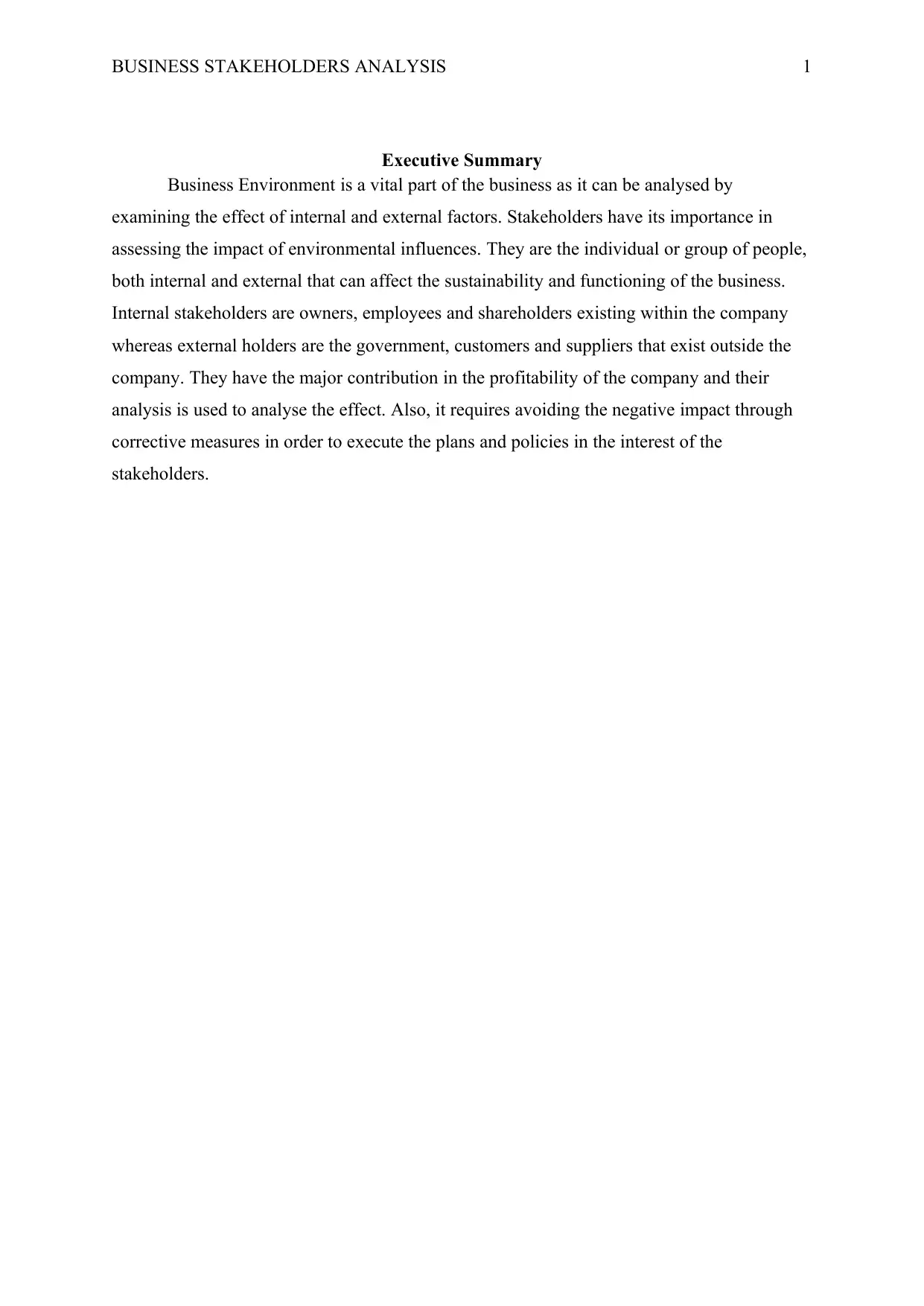
BUSINESS STAKEHOLDERS ANALYSIS 1
Executive Summary
Business Environment is a vital part of the business as it can be analysed by
examining the effect of internal and external factors. Stakeholders have its importance in
assessing the impact of environmental influences. They are the individual or group of people,
both internal and external that can affect the sustainability and functioning of the business.
Internal stakeholders are owners, employees and shareholders existing within the company
whereas external holders are the government, customers and suppliers that exist outside the
company. They have the major contribution in the profitability of the company and their
analysis is used to analyse the effect. Also, it requires avoiding the negative impact through
corrective measures in order to execute the plans and policies in the interest of the
stakeholders.
Executive Summary
Business Environment is a vital part of the business as it can be analysed by
examining the effect of internal and external factors. Stakeholders have its importance in
assessing the impact of environmental influences. They are the individual or group of people,
both internal and external that can affect the sustainability and functioning of the business.
Internal stakeholders are owners, employees and shareholders existing within the company
whereas external holders are the government, customers and suppliers that exist outside the
company. They have the major contribution in the profitability of the company and their
analysis is used to analyse the effect. Also, it requires avoiding the negative impact through
corrective measures in order to execute the plans and policies in the interest of the
stakeholders.
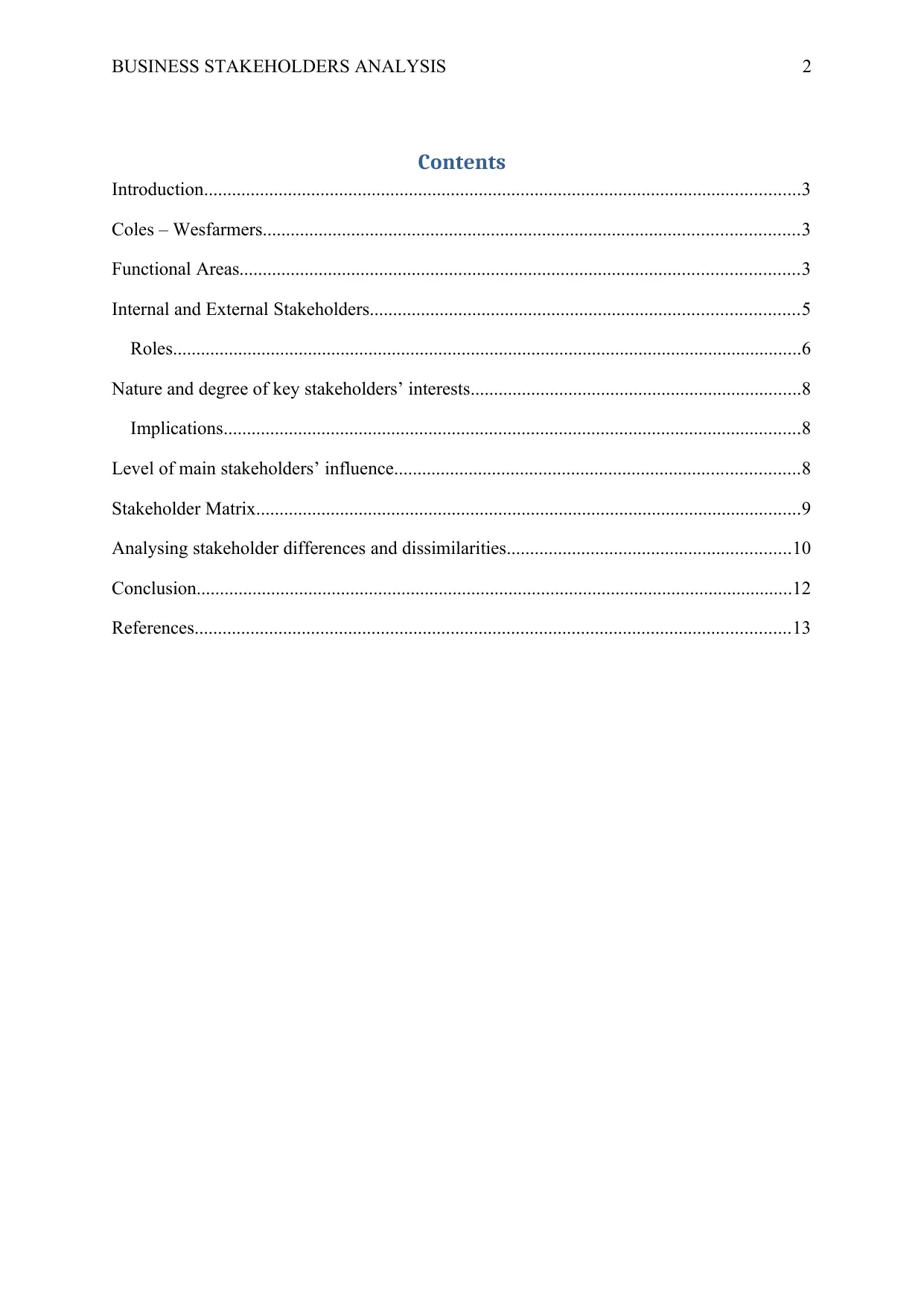
BUSINESS STAKEHOLDERS ANALYSIS 2
Contents
Introduction................................................................................................................................3
Coles – Wesfarmers...................................................................................................................3
Functional Areas........................................................................................................................3
Internal and External Stakeholders............................................................................................5
Roles.......................................................................................................................................6
Nature and degree of key stakeholders’ interests.......................................................................8
Implications............................................................................................................................8
Level of main stakeholders’ influence.......................................................................................8
Stakeholder Matrix.....................................................................................................................9
Analysing stakeholder differences and dissimilarities.............................................................10
Conclusion................................................................................................................................12
References................................................................................................................................13
Contents
Introduction................................................................................................................................3
Coles – Wesfarmers...................................................................................................................3
Functional Areas........................................................................................................................3
Internal and External Stakeholders............................................................................................5
Roles.......................................................................................................................................6
Nature and degree of key stakeholders’ interests.......................................................................8
Implications............................................................................................................................8
Level of main stakeholders’ influence.......................................................................................8
Stakeholder Matrix.....................................................................................................................9
Analysing stakeholder differences and dissimilarities.............................................................10
Conclusion................................................................................................................................12
References................................................................................................................................13
⊘ This is a preview!⊘
Do you want full access?
Subscribe today to unlock all pages.

Trusted by 1+ million students worldwide
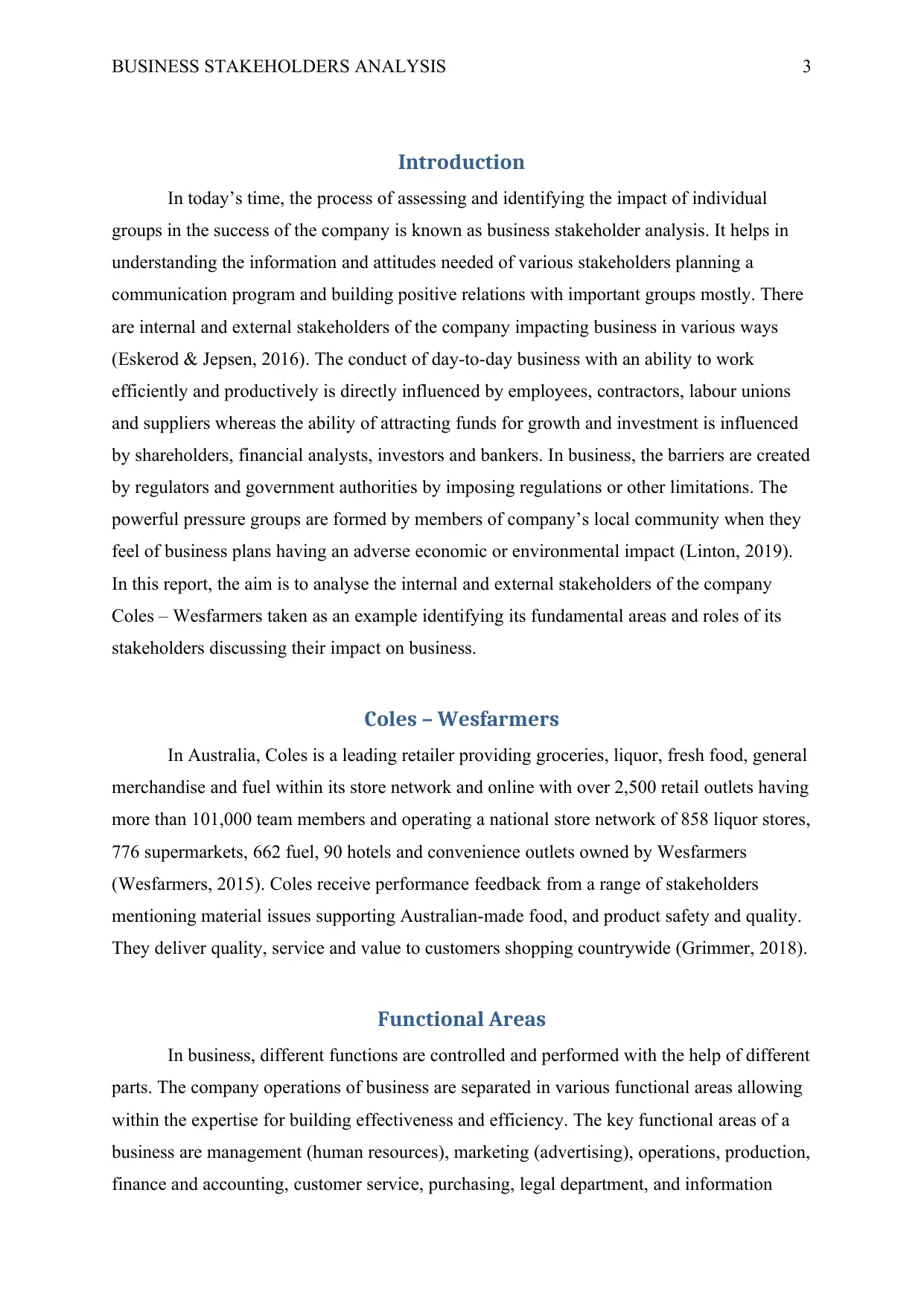
BUSINESS STAKEHOLDERS ANALYSIS 3
Introduction
In today’s time, the process of assessing and identifying the impact of individual
groups in the success of the company is known as business stakeholder analysis. It helps in
understanding the information and attitudes needed of various stakeholders planning a
communication program and building positive relations with important groups mostly. There
are internal and external stakeholders of the company impacting business in various ways
(Eskerod & Jepsen, 2016). The conduct of day-to-day business with an ability to work
efficiently and productively is directly influenced by employees, contractors, labour unions
and suppliers whereas the ability of attracting funds for growth and investment is influenced
by shareholders, financial analysts, investors and bankers. In business, the barriers are created
by regulators and government authorities by imposing regulations or other limitations. The
powerful pressure groups are formed by members of company’s local community when they
feel of business plans having an adverse economic or environmental impact (Linton, 2019).
In this report, the aim is to analyse the internal and external stakeholders of the company
Coles – Wesfarmers taken as an example identifying its fundamental areas and roles of its
stakeholders discussing their impact on business.
Coles – Wesfarmers
In Australia, Coles is a leading retailer providing groceries, liquor, fresh food, general
merchandise and fuel within its store network and online with over 2,500 retail outlets having
more than 101,000 team members and operating a national store network of 858 liquor stores,
776 supermarkets, 662 fuel, 90 hotels and convenience outlets owned by Wesfarmers
(Wesfarmers, 2015). Coles receive performance feedback from a range of stakeholders
mentioning material issues supporting Australian-made food, and product safety and quality.
They deliver quality, service and value to customers shopping countrywide (Grimmer, 2018).
Functional Areas
In business, different functions are controlled and performed with the help of different
parts. The company operations of business are separated in various functional areas allowing
within the expertise for building effectiveness and efficiency. The key functional areas of a
business are management (human resources), marketing (advertising), operations, production,
finance and accounting, customer service, purchasing, legal department, and information
Introduction
In today’s time, the process of assessing and identifying the impact of individual
groups in the success of the company is known as business stakeholder analysis. It helps in
understanding the information and attitudes needed of various stakeholders planning a
communication program and building positive relations with important groups mostly. There
are internal and external stakeholders of the company impacting business in various ways
(Eskerod & Jepsen, 2016). The conduct of day-to-day business with an ability to work
efficiently and productively is directly influenced by employees, contractors, labour unions
and suppliers whereas the ability of attracting funds for growth and investment is influenced
by shareholders, financial analysts, investors and bankers. In business, the barriers are created
by regulators and government authorities by imposing regulations or other limitations. The
powerful pressure groups are formed by members of company’s local community when they
feel of business plans having an adverse economic or environmental impact (Linton, 2019).
In this report, the aim is to analyse the internal and external stakeholders of the company
Coles – Wesfarmers taken as an example identifying its fundamental areas and roles of its
stakeholders discussing their impact on business.
Coles – Wesfarmers
In Australia, Coles is a leading retailer providing groceries, liquor, fresh food, general
merchandise and fuel within its store network and online with over 2,500 retail outlets having
more than 101,000 team members and operating a national store network of 858 liquor stores,
776 supermarkets, 662 fuel, 90 hotels and convenience outlets owned by Wesfarmers
(Wesfarmers, 2015). Coles receive performance feedback from a range of stakeholders
mentioning material issues supporting Australian-made food, and product safety and quality.
They deliver quality, service and value to customers shopping countrywide (Grimmer, 2018).
Functional Areas
In business, different functions are controlled and performed with the help of different
parts. The company operations of business are separated in various functional areas allowing
within the expertise for building effectiveness and efficiency. The key functional areas of a
business are management (human resources), marketing (advertising), operations, production,
finance and accounting, customer service, purchasing, legal department, and information
Paraphrase This Document
Need a fresh take? Get an instant paraphrase of this document with our AI Paraphraser
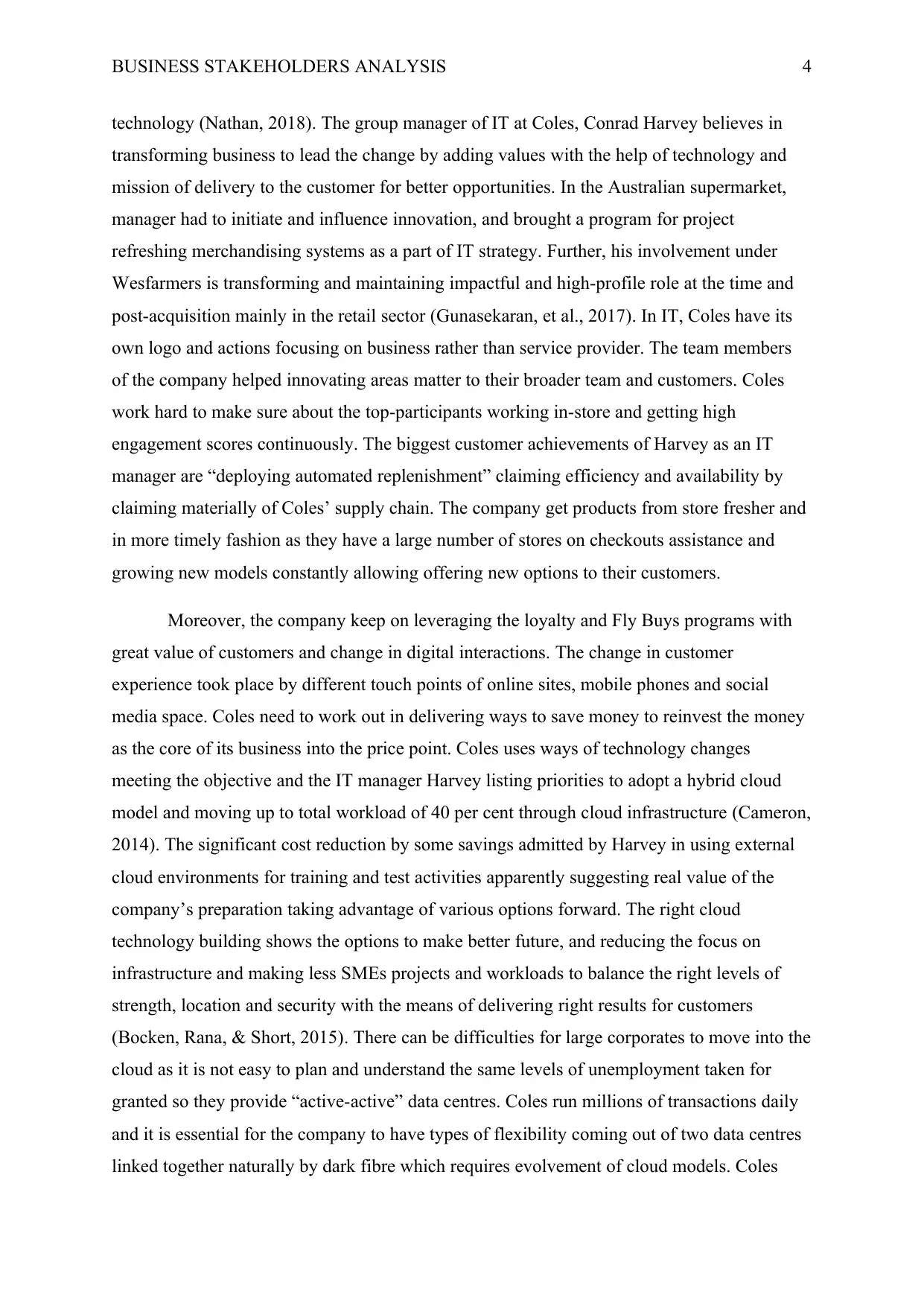
BUSINESS STAKEHOLDERS ANALYSIS 4
technology (Nathan, 2018). The group manager of IT at Coles, Conrad Harvey believes in
transforming business to lead the change by adding values with the help of technology and
mission of delivery to the customer for better opportunities. In the Australian supermarket,
manager had to initiate and influence innovation, and brought a program for project
refreshing merchandising systems as a part of IT strategy. Further, his involvement under
Wesfarmers is transforming and maintaining impactful and high-profile role at the time and
post-acquisition mainly in the retail sector (Gunasekaran, et al., 2017). In IT, Coles have its
own logo and actions focusing on business rather than service provider. The team members
of the company helped innovating areas matter to their broader team and customers. Coles
work hard to make sure about the top-participants working in-store and getting high
engagement scores continuously. The biggest customer achievements of Harvey as an IT
manager are “deploying automated replenishment” claiming efficiency and availability by
claiming materially of Coles’ supply chain. The company get products from store fresher and
in more timely fashion as they have a large number of stores on checkouts assistance and
growing new models constantly allowing offering new options to their customers.
Moreover, the company keep on leveraging the loyalty and Fly Buys programs with
great value of customers and change in digital interactions. The change in customer
experience took place by different touch points of online sites, mobile phones and social
media space. Coles need to work out in delivering ways to save money to reinvest the money
as the core of its business into the price point. Coles uses ways of technology changes
meeting the objective and the IT manager Harvey listing priorities to adopt a hybrid cloud
model and moving up to total workload of 40 per cent through cloud infrastructure (Cameron,
2014). The significant cost reduction by some savings admitted by Harvey in using external
cloud environments for training and test activities apparently suggesting real value of the
company’s preparation taking advantage of various options forward. The right cloud
technology building shows the options to make better future, and reducing the focus on
infrastructure and making less SMEs projects and workloads to balance the right levels of
strength, location and security with the means of delivering right results for customers
(Bocken, Rana, & Short, 2015). There can be difficulties for large corporates to move into the
cloud as it is not easy to plan and understand the same levels of unemployment taken for
granted so they provide “active-active” data centres. Coles run millions of transactions daily
and it is essential for the company to have types of flexibility coming out of two data centres
linked together naturally by dark fibre which requires evolvement of cloud models. Coles
technology (Nathan, 2018). The group manager of IT at Coles, Conrad Harvey believes in
transforming business to lead the change by adding values with the help of technology and
mission of delivery to the customer for better opportunities. In the Australian supermarket,
manager had to initiate and influence innovation, and brought a program for project
refreshing merchandising systems as a part of IT strategy. Further, his involvement under
Wesfarmers is transforming and maintaining impactful and high-profile role at the time and
post-acquisition mainly in the retail sector (Gunasekaran, et al., 2017). In IT, Coles have its
own logo and actions focusing on business rather than service provider. The team members
of the company helped innovating areas matter to their broader team and customers. Coles
work hard to make sure about the top-participants working in-store and getting high
engagement scores continuously. The biggest customer achievements of Harvey as an IT
manager are “deploying automated replenishment” claiming efficiency and availability by
claiming materially of Coles’ supply chain. The company get products from store fresher and
in more timely fashion as they have a large number of stores on checkouts assistance and
growing new models constantly allowing offering new options to their customers.
Moreover, the company keep on leveraging the loyalty and Fly Buys programs with
great value of customers and change in digital interactions. The change in customer
experience took place by different touch points of online sites, mobile phones and social
media space. Coles need to work out in delivering ways to save money to reinvest the money
as the core of its business into the price point. Coles uses ways of technology changes
meeting the objective and the IT manager Harvey listing priorities to adopt a hybrid cloud
model and moving up to total workload of 40 per cent through cloud infrastructure (Cameron,
2014). The significant cost reduction by some savings admitted by Harvey in using external
cloud environments for training and test activities apparently suggesting real value of the
company’s preparation taking advantage of various options forward. The right cloud
technology building shows the options to make better future, and reducing the focus on
infrastructure and making less SMEs projects and workloads to balance the right levels of
strength, location and security with the means of delivering right results for customers
(Bocken, Rana, & Short, 2015). There can be difficulties for large corporates to move into the
cloud as it is not easy to plan and understand the same levels of unemployment taken for
granted so they provide “active-active” data centres. Coles run millions of transactions daily
and it is essential for the company to have types of flexibility coming out of two data centres
linked together naturally by dark fibre which requires evolvement of cloud models. Coles
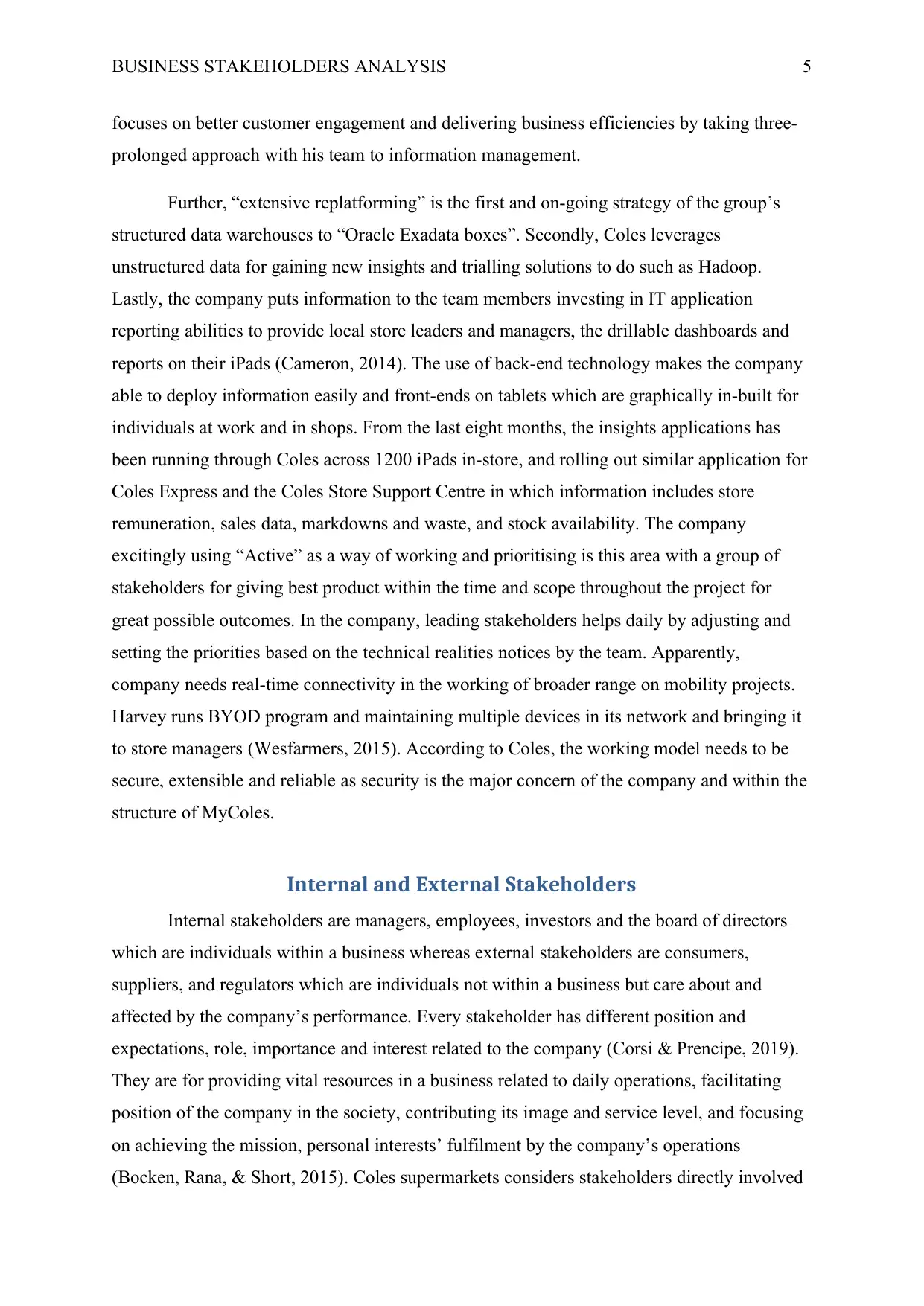
BUSINESS STAKEHOLDERS ANALYSIS 5
focuses on better customer engagement and delivering business efficiencies by taking three-
prolonged approach with his team to information management.
Further, “extensive replatforming” is the first and on-going strategy of the group’s
structured data warehouses to “Oracle Exadata boxes”. Secondly, Coles leverages
unstructured data for gaining new insights and trialling solutions to do such as Hadoop.
Lastly, the company puts information to the team members investing in IT application
reporting abilities to provide local store leaders and managers, the drillable dashboards and
reports on their iPads (Cameron, 2014). The use of back-end technology makes the company
able to deploy information easily and front-ends on tablets which are graphically in-built for
individuals at work and in shops. From the last eight months, the insights applications has
been running through Coles across 1200 iPads in-store, and rolling out similar application for
Coles Express and the Coles Store Support Centre in which information includes store
remuneration, sales data, markdowns and waste, and stock availability. The company
excitingly using “Active” as a way of working and prioritising is this area with a group of
stakeholders for giving best product within the time and scope throughout the project for
great possible outcomes. In the company, leading stakeholders helps daily by adjusting and
setting the priorities based on the technical realities notices by the team. Apparently,
company needs real-time connectivity in the working of broader range on mobility projects.
Harvey runs BYOD program and maintaining multiple devices in its network and bringing it
to store managers (Wesfarmers, 2015). According to Coles, the working model needs to be
secure, extensible and reliable as security is the major concern of the company and within the
structure of MyColes.
Internal and External Stakeholders
Internal stakeholders are managers, employees, investors and the board of directors
which are individuals within a business whereas external stakeholders are consumers,
suppliers, and regulators which are individuals not within a business but care about and
affected by the company’s performance. Every stakeholder has different position and
expectations, role, importance and interest related to the company (Corsi & Prencipe, 2019).
They are for providing vital resources in a business related to daily operations, facilitating
position of the company in the society, contributing its image and service level, and focusing
on achieving the mission, personal interests’ fulfilment by the company’s operations
(Bocken, Rana, & Short, 2015). Coles supermarkets considers stakeholders directly involved
focuses on better customer engagement and delivering business efficiencies by taking three-
prolonged approach with his team to information management.
Further, “extensive replatforming” is the first and on-going strategy of the group’s
structured data warehouses to “Oracle Exadata boxes”. Secondly, Coles leverages
unstructured data for gaining new insights and trialling solutions to do such as Hadoop.
Lastly, the company puts information to the team members investing in IT application
reporting abilities to provide local store leaders and managers, the drillable dashboards and
reports on their iPads (Cameron, 2014). The use of back-end technology makes the company
able to deploy information easily and front-ends on tablets which are graphically in-built for
individuals at work and in shops. From the last eight months, the insights applications has
been running through Coles across 1200 iPads in-store, and rolling out similar application for
Coles Express and the Coles Store Support Centre in which information includes store
remuneration, sales data, markdowns and waste, and stock availability. The company
excitingly using “Active” as a way of working and prioritising is this area with a group of
stakeholders for giving best product within the time and scope throughout the project for
great possible outcomes. In the company, leading stakeholders helps daily by adjusting and
setting the priorities based on the technical realities notices by the team. Apparently,
company needs real-time connectivity in the working of broader range on mobility projects.
Harvey runs BYOD program and maintaining multiple devices in its network and bringing it
to store managers (Wesfarmers, 2015). According to Coles, the working model needs to be
secure, extensible and reliable as security is the major concern of the company and within the
structure of MyColes.
Internal and External Stakeholders
Internal stakeholders are managers, employees, investors and the board of directors
which are individuals within a business whereas external stakeholders are consumers,
suppliers, and regulators which are individuals not within a business but care about and
affected by the company’s performance. Every stakeholder has different position and
expectations, role, importance and interest related to the company (Corsi & Prencipe, 2019).
They are for providing vital resources in a business related to daily operations, facilitating
position of the company in the society, contributing its image and service level, and focusing
on achieving the mission, personal interests’ fulfilment by the company’s operations
(Bocken, Rana, & Short, 2015). Coles supermarkets considers stakeholders directly involved
⊘ This is a preview!⊘
Do you want full access?
Subscribe today to unlock all pages.

Trusted by 1+ million students worldwide
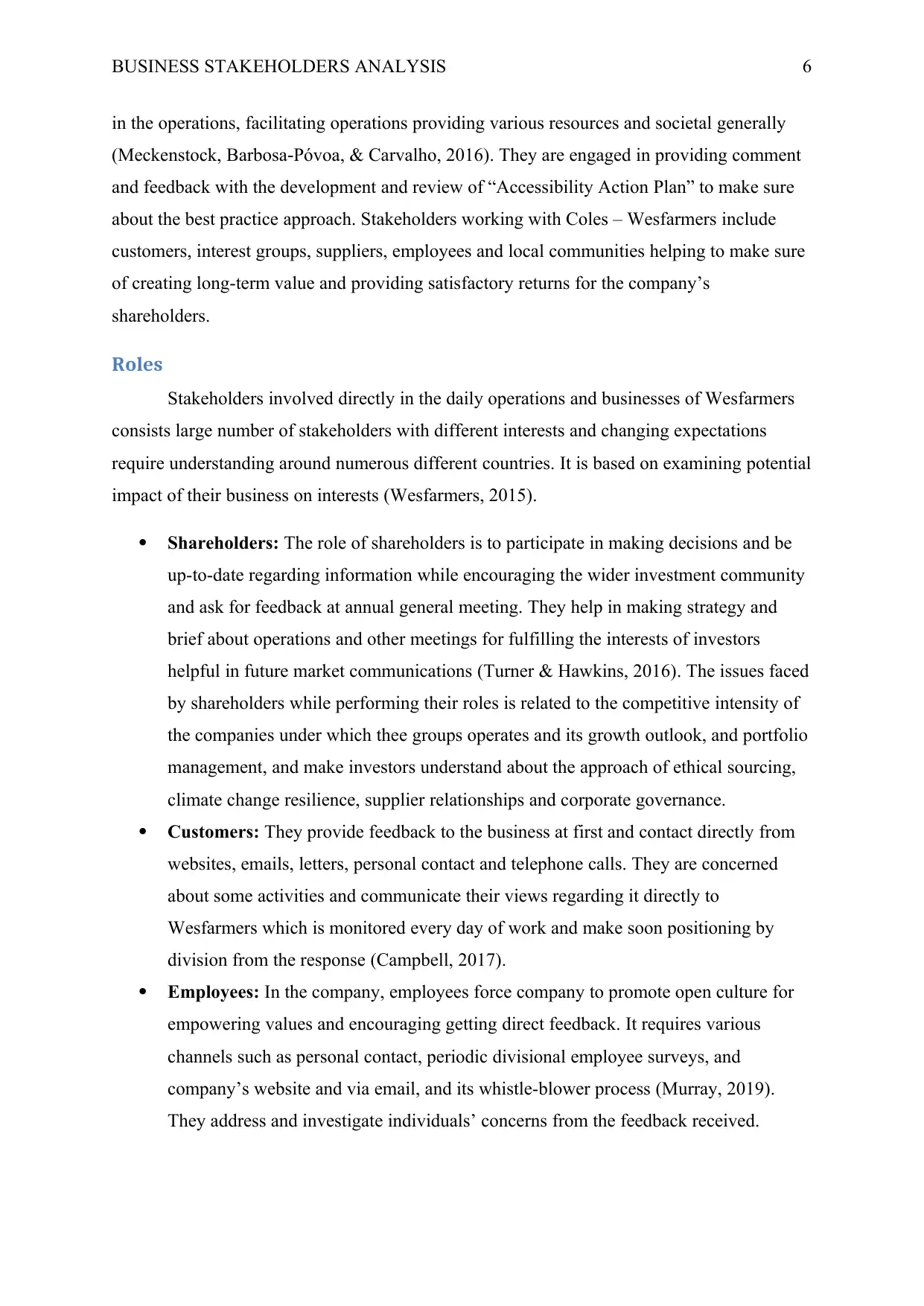
BUSINESS STAKEHOLDERS ANALYSIS 6
in the operations, facilitating operations providing various resources and societal generally
(Meckenstock, Barbosa Póvoa, & Carvalho, 2016)‐ . They are engaged in providing comment
and feedback with the development and review of “Accessibility Action Plan” to make sure
about the best practice approach. Stakeholders working with Coles – Wesfarmers include
customers, interest groups, suppliers, employees and local communities helping to make sure
of creating long-term value and providing satisfactory returns for the company’s
shareholders.
Roles
Stakeholders involved directly in the daily operations and businesses of Wesfarmers
consists large number of stakeholders with different interests and changing expectations
require understanding around numerous different countries. It is based on examining potential
impact of their business on interests (Wesfarmers, 2015).
Shareholders: The role of shareholders is to participate in making decisions and be
up-to-date regarding information while encouraging the wider investment community
and ask for feedback at annual general meeting. They help in making strategy and
brief about operations and other meetings for fulfilling the interests of investors
helpful in future market communications (Turner & Hawkins, 2016). The issues faced
by shareholders while performing their roles is related to the competitive intensity of
the companies under which thee groups operates and its growth outlook, and portfolio
management, and make investors understand about the approach of ethical sourcing,
climate change resilience, supplier relationships and corporate governance.
Customers: They provide feedback to the business at first and contact directly from
websites, emails, letters, personal contact and telephone calls. They are concerned
about some activities and communicate their views regarding it directly to
Wesfarmers which is monitored every day of work and make soon positioning by
division from the response (Campbell, 2017).
Employees: In the company, employees force company to promote open culture for
empowering values and encouraging getting direct feedback. It requires various
channels such as personal contact, periodic divisional employee surveys, and
company’s website and via email, and its whistle-blower process (Murray, 2019).
They address and investigate individuals’ concerns from the feedback received.
in the operations, facilitating operations providing various resources and societal generally
(Meckenstock, Barbosa Póvoa, & Carvalho, 2016)‐ . They are engaged in providing comment
and feedback with the development and review of “Accessibility Action Plan” to make sure
about the best practice approach. Stakeholders working with Coles – Wesfarmers include
customers, interest groups, suppliers, employees and local communities helping to make sure
of creating long-term value and providing satisfactory returns for the company’s
shareholders.
Roles
Stakeholders involved directly in the daily operations and businesses of Wesfarmers
consists large number of stakeholders with different interests and changing expectations
require understanding around numerous different countries. It is based on examining potential
impact of their business on interests (Wesfarmers, 2015).
Shareholders: The role of shareholders is to participate in making decisions and be
up-to-date regarding information while encouraging the wider investment community
and ask for feedback at annual general meeting. They help in making strategy and
brief about operations and other meetings for fulfilling the interests of investors
helpful in future market communications (Turner & Hawkins, 2016). The issues faced
by shareholders while performing their roles is related to the competitive intensity of
the companies under which thee groups operates and its growth outlook, and portfolio
management, and make investors understand about the approach of ethical sourcing,
climate change resilience, supplier relationships and corporate governance.
Customers: They provide feedback to the business at first and contact directly from
websites, emails, letters, personal contact and telephone calls. They are concerned
about some activities and communicate their views regarding it directly to
Wesfarmers which is monitored every day of work and make soon positioning by
division from the response (Campbell, 2017).
Employees: In the company, employees force company to promote open culture for
empowering values and encouraging getting direct feedback. It requires various
channels such as personal contact, periodic divisional employee surveys, and
company’s website and via email, and its whistle-blower process (Murray, 2019).
They address and investigate individuals’ concerns from the feedback received.
Paraphrase This Document
Need a fresh take? Get an instant paraphrase of this document with our AI Paraphraser
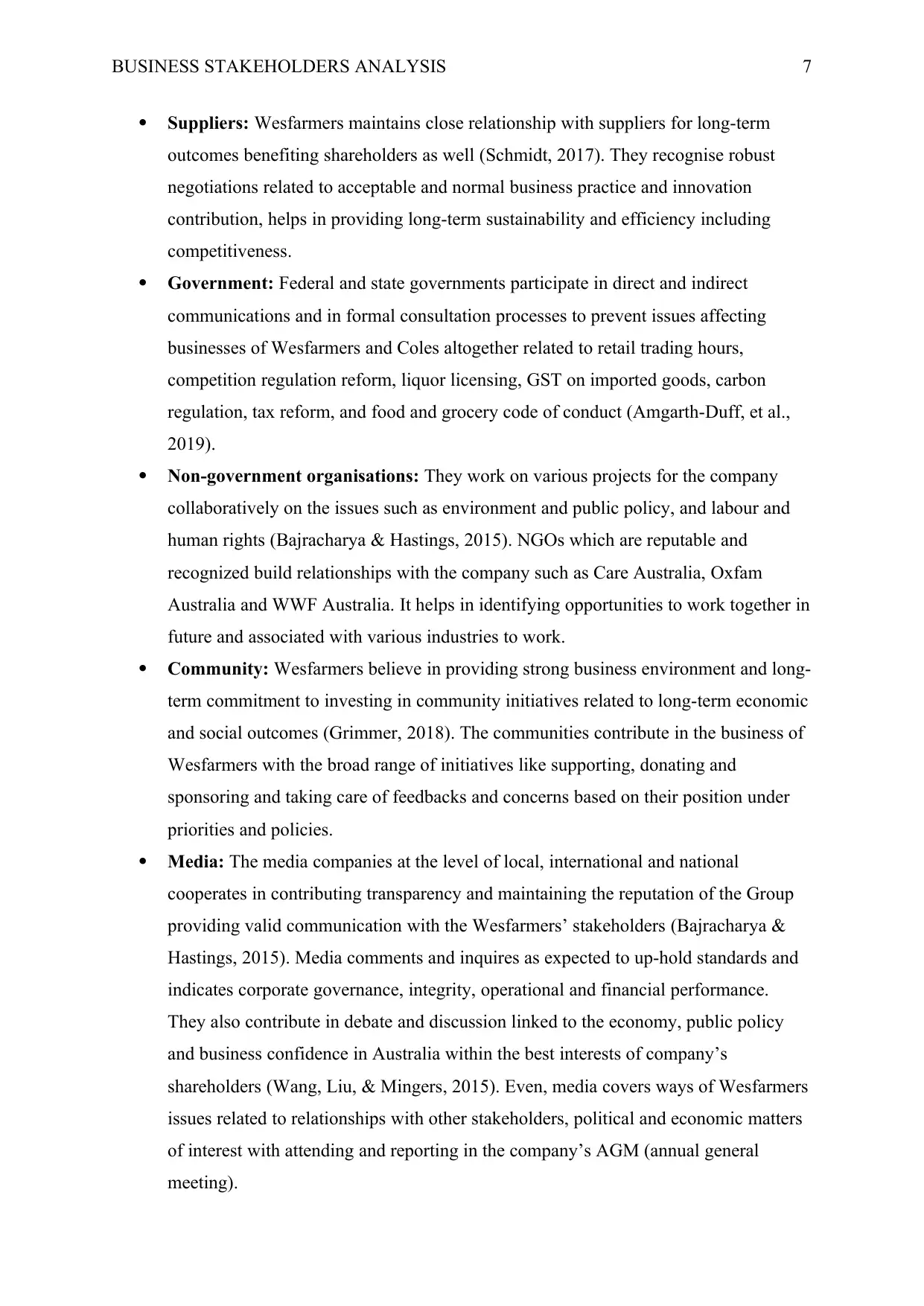
BUSINESS STAKEHOLDERS ANALYSIS 7
Suppliers: Wesfarmers maintains close relationship with suppliers for long-term
outcomes benefiting shareholders as well (Schmidt, 2017). They recognise robust
negotiations related to acceptable and normal business practice and innovation
contribution, helps in providing long-term sustainability and efficiency including
competitiveness.
Government: Federal and state governments participate in direct and indirect
communications and in formal consultation processes to prevent issues affecting
businesses of Wesfarmers and Coles altogether related to retail trading hours,
competition regulation reform, liquor licensing, GST on imported goods, carbon
regulation, tax reform, and food and grocery code of conduct (Amgarth-Duff, et al.,
2019).
Non-government organisations: They work on various projects for the company
collaboratively on the issues such as environment and public policy, and labour and
human rights (Bajracharya & Hastings, 2015). NGOs which are reputable and
recognized build relationships with the company such as Care Australia, Oxfam
Australia and WWF Australia. It helps in identifying opportunities to work together in
future and associated with various industries to work.
Community: Wesfarmers believe in providing strong business environment and long-
term commitment to investing in community initiatives related to long-term economic
and social outcomes (Grimmer, 2018). The communities contribute in the business of
Wesfarmers with the broad range of initiatives like supporting, donating and
sponsoring and taking care of feedbacks and concerns based on their position under
priorities and policies.
Media: The media companies at the level of local, international and national
cooperates in contributing transparency and maintaining the reputation of the Group
providing valid communication with the Wesfarmers’ stakeholders (Bajracharya &
Hastings, 2015). Media comments and inquires as expected to up-hold standards and
indicates corporate governance, integrity, operational and financial performance.
They also contribute in debate and discussion linked to the economy, public policy
and business confidence in Australia within the best interests of company’s
shareholders (Wang, Liu, & Mingers, 2015). Even, media covers ways of Wesfarmers
issues related to relationships with other stakeholders, political and economic matters
of interest with attending and reporting in the company’s AGM (annual general
meeting).
Suppliers: Wesfarmers maintains close relationship with suppliers for long-term
outcomes benefiting shareholders as well (Schmidt, 2017). They recognise robust
negotiations related to acceptable and normal business practice and innovation
contribution, helps in providing long-term sustainability and efficiency including
competitiveness.
Government: Federal and state governments participate in direct and indirect
communications and in formal consultation processes to prevent issues affecting
businesses of Wesfarmers and Coles altogether related to retail trading hours,
competition regulation reform, liquor licensing, GST on imported goods, carbon
regulation, tax reform, and food and grocery code of conduct (Amgarth-Duff, et al.,
2019).
Non-government organisations: They work on various projects for the company
collaboratively on the issues such as environment and public policy, and labour and
human rights (Bajracharya & Hastings, 2015). NGOs which are reputable and
recognized build relationships with the company such as Care Australia, Oxfam
Australia and WWF Australia. It helps in identifying opportunities to work together in
future and associated with various industries to work.
Community: Wesfarmers believe in providing strong business environment and long-
term commitment to investing in community initiatives related to long-term economic
and social outcomes (Grimmer, 2018). The communities contribute in the business of
Wesfarmers with the broad range of initiatives like supporting, donating and
sponsoring and taking care of feedbacks and concerns based on their position under
priorities and policies.
Media: The media companies at the level of local, international and national
cooperates in contributing transparency and maintaining the reputation of the Group
providing valid communication with the Wesfarmers’ stakeholders (Bajracharya &
Hastings, 2015). Media comments and inquires as expected to up-hold standards and
indicates corporate governance, integrity, operational and financial performance.
They also contribute in debate and discussion linked to the economy, public policy
and business confidence in Australia within the best interests of company’s
shareholders (Wang, Liu, & Mingers, 2015). Even, media covers ways of Wesfarmers
issues related to relationships with other stakeholders, political and economic matters
of interest with attending and reporting in the company’s AGM (annual general
meeting).
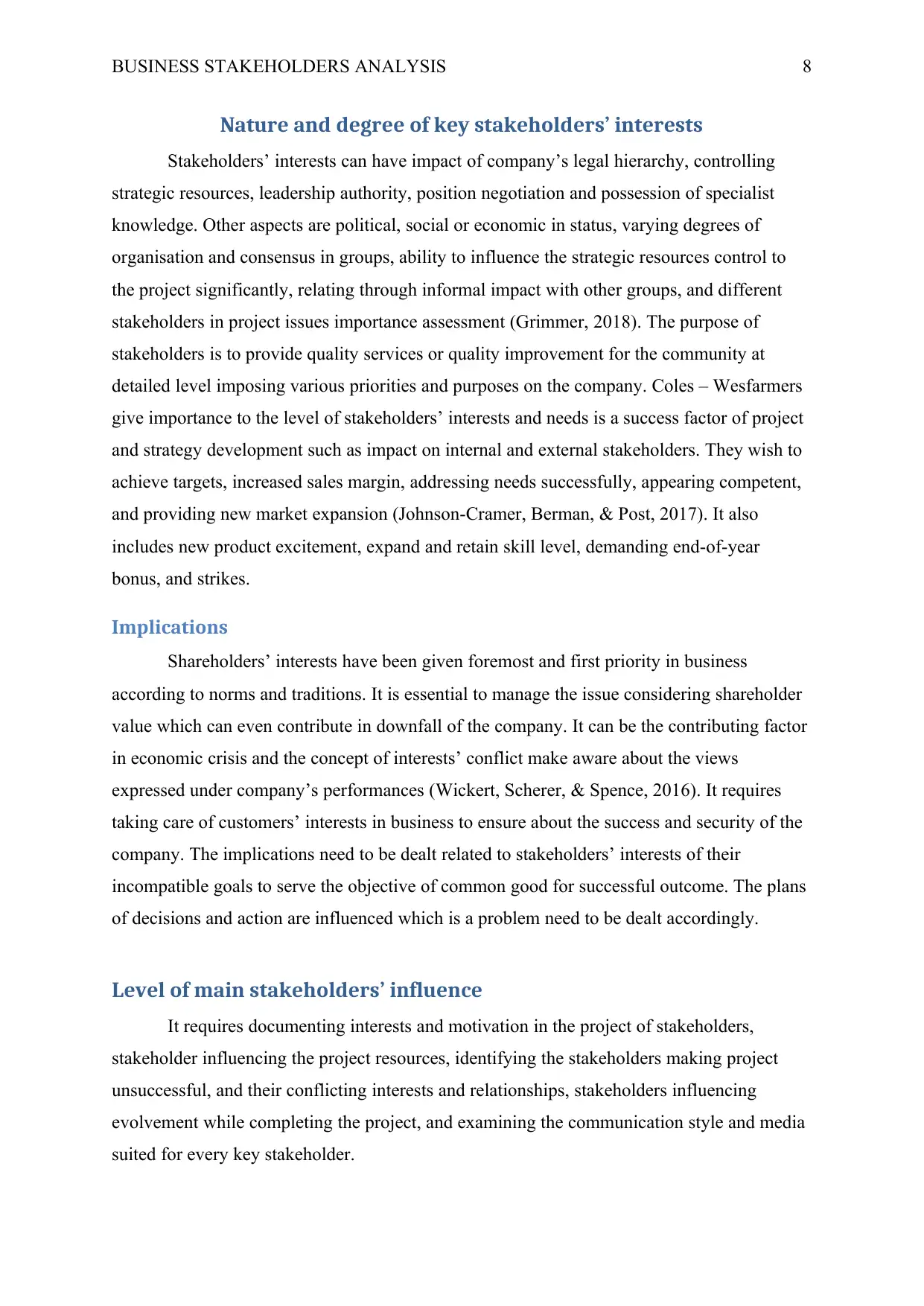
BUSINESS STAKEHOLDERS ANALYSIS 8
Nature and degree of key stakeholders’ interests
Stakeholders’ interests can have impact of company’s legal hierarchy, controlling
strategic resources, leadership authority, position negotiation and possession of specialist
knowledge. Other aspects are political, social or economic in status, varying degrees of
organisation and consensus in groups, ability to influence the strategic resources control to
the project significantly, relating through informal impact with other groups, and different
stakeholders in project issues importance assessment (Grimmer, 2018). The purpose of
stakeholders is to provide quality services or quality improvement for the community at
detailed level imposing various priorities and purposes on the company. Coles – Wesfarmers
give importance to the level of stakeholders’ interests and needs is a success factor of project
and strategy development such as impact on internal and external stakeholders. They wish to
achieve targets, increased sales margin, addressing needs successfully, appearing competent,
and providing new market expansion (Johnson-Cramer, Berman, & Post, 2017). It also
includes new product excitement, expand and retain skill level, demanding end-of-year
bonus, and strikes.
Implications
Shareholders’ interests have been given foremost and first priority in business
according to norms and traditions. It is essential to manage the issue considering shareholder
value which can even contribute in downfall of the company. It can be the contributing factor
in economic crisis and the concept of interests’ conflict make aware about the views
expressed under company’s performances (Wickert, Scherer, & Spence, 2016). It requires
taking care of customers’ interests in business to ensure about the success and security of the
company. The implications need to be dealt related to stakeholders’ interests of their
incompatible goals to serve the objective of common good for successful outcome. The plans
of decisions and action are influenced which is a problem need to be dealt accordingly.
Level of main stakeholders’ influence
It requires documenting interests and motivation in the project of stakeholders,
stakeholder influencing the project resources, identifying the stakeholders making project
unsuccessful, and their conflicting interests and relationships, stakeholders influencing
evolvement while completing the project, and examining the communication style and media
suited for every key stakeholder.
Nature and degree of key stakeholders’ interests
Stakeholders’ interests can have impact of company’s legal hierarchy, controlling
strategic resources, leadership authority, position negotiation and possession of specialist
knowledge. Other aspects are political, social or economic in status, varying degrees of
organisation and consensus in groups, ability to influence the strategic resources control to
the project significantly, relating through informal impact with other groups, and different
stakeholders in project issues importance assessment (Grimmer, 2018). The purpose of
stakeholders is to provide quality services or quality improvement for the community at
detailed level imposing various priorities and purposes on the company. Coles – Wesfarmers
give importance to the level of stakeholders’ interests and needs is a success factor of project
and strategy development such as impact on internal and external stakeholders. They wish to
achieve targets, increased sales margin, addressing needs successfully, appearing competent,
and providing new market expansion (Johnson-Cramer, Berman, & Post, 2017). It also
includes new product excitement, expand and retain skill level, demanding end-of-year
bonus, and strikes.
Implications
Shareholders’ interests have been given foremost and first priority in business
according to norms and traditions. It is essential to manage the issue considering shareholder
value which can even contribute in downfall of the company. It can be the contributing factor
in economic crisis and the concept of interests’ conflict make aware about the views
expressed under company’s performances (Wickert, Scherer, & Spence, 2016). It requires
taking care of customers’ interests in business to ensure about the success and security of the
company. The implications need to be dealt related to stakeholders’ interests of their
incompatible goals to serve the objective of common good for successful outcome. The plans
of decisions and action are influenced which is a problem need to be dealt accordingly.
Level of main stakeholders’ influence
It requires documenting interests and motivation in the project of stakeholders,
stakeholder influencing the project resources, identifying the stakeholders making project
unsuccessful, and their conflicting interests and relationships, stakeholders influencing
evolvement while completing the project, and examining the communication style and media
suited for every key stakeholder.
⊘ This is a preview!⊘
Do you want full access?
Subscribe today to unlock all pages.

Trusted by 1+ million students worldwide
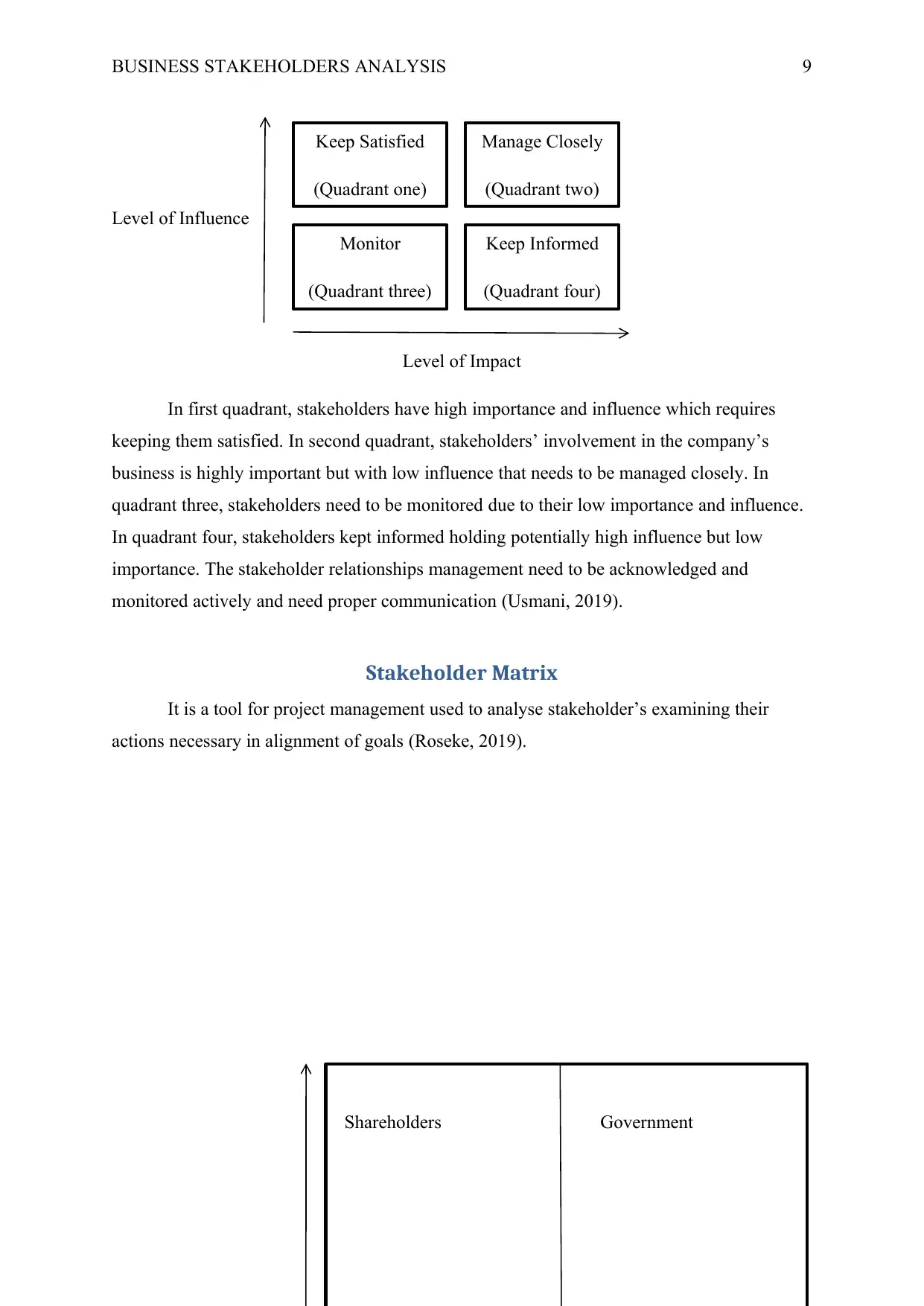
BUSINESS STAKEHOLDERS ANALYSIS 9
Level of Influence
Level of Impact
In first quadrant, stakeholders have high importance and influence which requires
keeping them satisfied. In second quadrant, stakeholders’ involvement in the company’s
business is highly important but with low influence that needs to be managed closely. In
quadrant three, stakeholders need to be monitored due to their low importance and influence.
In quadrant four, stakeholders kept informed holding potentially high influence but low
importance. The stakeholder relationships management need to be acknowledged and
monitored actively and need proper communication (Usmani, 2019).
Stakeholder Matrix
It is a tool for project management used to analyse stakeholder’s examining their
actions necessary in alignment of goals (Roseke, 2019).
Shareholders Government
Keep Satisfied
(Quadrant one)
Manage Closely
(Quadrant two)
Monitor
(Quadrant three)
Keep Informed
(Quadrant four)
Level of Influence
Level of Impact
In first quadrant, stakeholders have high importance and influence which requires
keeping them satisfied. In second quadrant, stakeholders’ involvement in the company’s
business is highly important but with low influence that needs to be managed closely. In
quadrant three, stakeholders need to be monitored due to their low importance and influence.
In quadrant four, stakeholders kept informed holding potentially high influence but low
importance. The stakeholder relationships management need to be acknowledged and
monitored actively and need proper communication (Usmani, 2019).
Stakeholder Matrix
It is a tool for project management used to analyse stakeholder’s examining their
actions necessary in alignment of goals (Roseke, 2019).
Shareholders Government
Keep Satisfied
(Quadrant one)
Manage Closely
(Quadrant two)
Monitor
(Quadrant three)
Keep Informed
(Quadrant four)
Paraphrase This Document
Need a fresh take? Get an instant paraphrase of this document with our AI Paraphraser
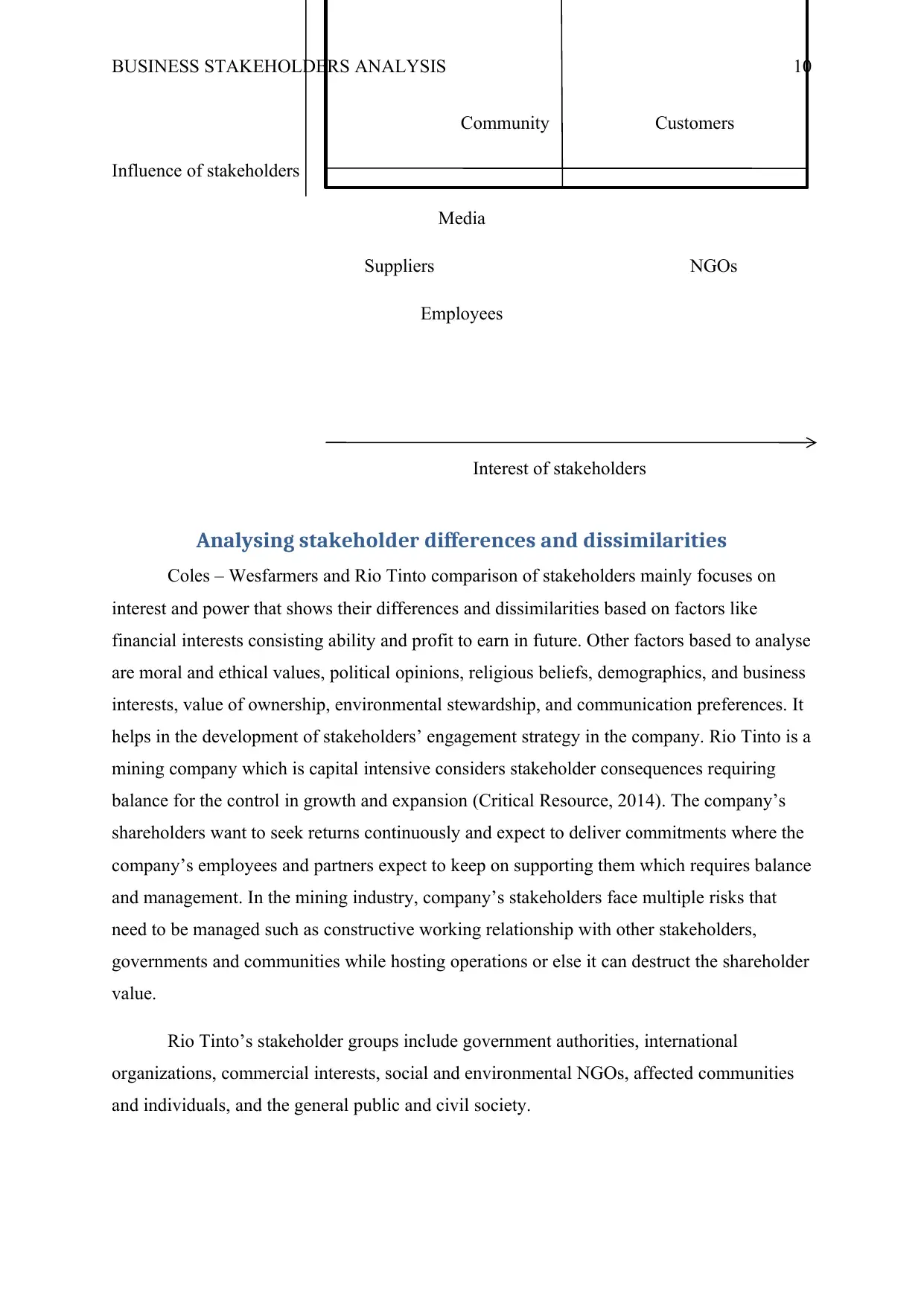
BUSINESS STAKEHOLDERS ANALYSIS 10
Community Customers
Influence of stakeholders
Media
Suppliers NGOs
Employees
Interest of stakeholders
Analysing stakeholder differences and dissimilarities
Coles – Wesfarmers and Rio Tinto comparison of stakeholders mainly focuses on
interest and power that shows their differences and dissimilarities based on factors like
financial interests consisting ability and profit to earn in future. Other factors based to analyse
are moral and ethical values, political opinions, religious beliefs, demographics, and business
interests, value of ownership, environmental stewardship, and communication preferences. It
helps in the development of stakeholders’ engagement strategy in the company. Rio Tinto is a
mining company which is capital intensive considers stakeholder consequences requiring
balance for the control in growth and expansion (Critical Resource, 2014). The company’s
shareholders want to seek returns continuously and expect to deliver commitments where the
company’s employees and partners expect to keep on supporting them which requires balance
and management. In the mining industry, company’s stakeholders face multiple risks that
need to be managed such as constructive working relationship with other stakeholders,
governments and communities while hosting operations or else it can destruct the shareholder
value.
Rio Tinto’s stakeholder groups include government authorities, international
organizations, commercial interests, social and environmental NGOs, affected communities
and individuals, and the general public and civil society.
Community Customers
Influence of stakeholders
Media
Suppliers NGOs
Employees
Interest of stakeholders
Analysing stakeholder differences and dissimilarities
Coles – Wesfarmers and Rio Tinto comparison of stakeholders mainly focuses on
interest and power that shows their differences and dissimilarities based on factors like
financial interests consisting ability and profit to earn in future. Other factors based to analyse
are moral and ethical values, political opinions, religious beliefs, demographics, and business
interests, value of ownership, environmental stewardship, and communication preferences. It
helps in the development of stakeholders’ engagement strategy in the company. Rio Tinto is a
mining company which is capital intensive considers stakeholder consequences requiring
balance for the control in growth and expansion (Critical Resource, 2014). The company’s
shareholders want to seek returns continuously and expect to deliver commitments where the
company’s employees and partners expect to keep on supporting them which requires balance
and management. In the mining industry, company’s stakeholders face multiple risks that
need to be managed such as constructive working relationship with other stakeholders,
governments and communities while hosting operations or else it can destruct the shareholder
value.
Rio Tinto’s stakeholder groups include government authorities, international
organizations, commercial interests, social and environmental NGOs, affected communities
and individuals, and the general public and civil society.
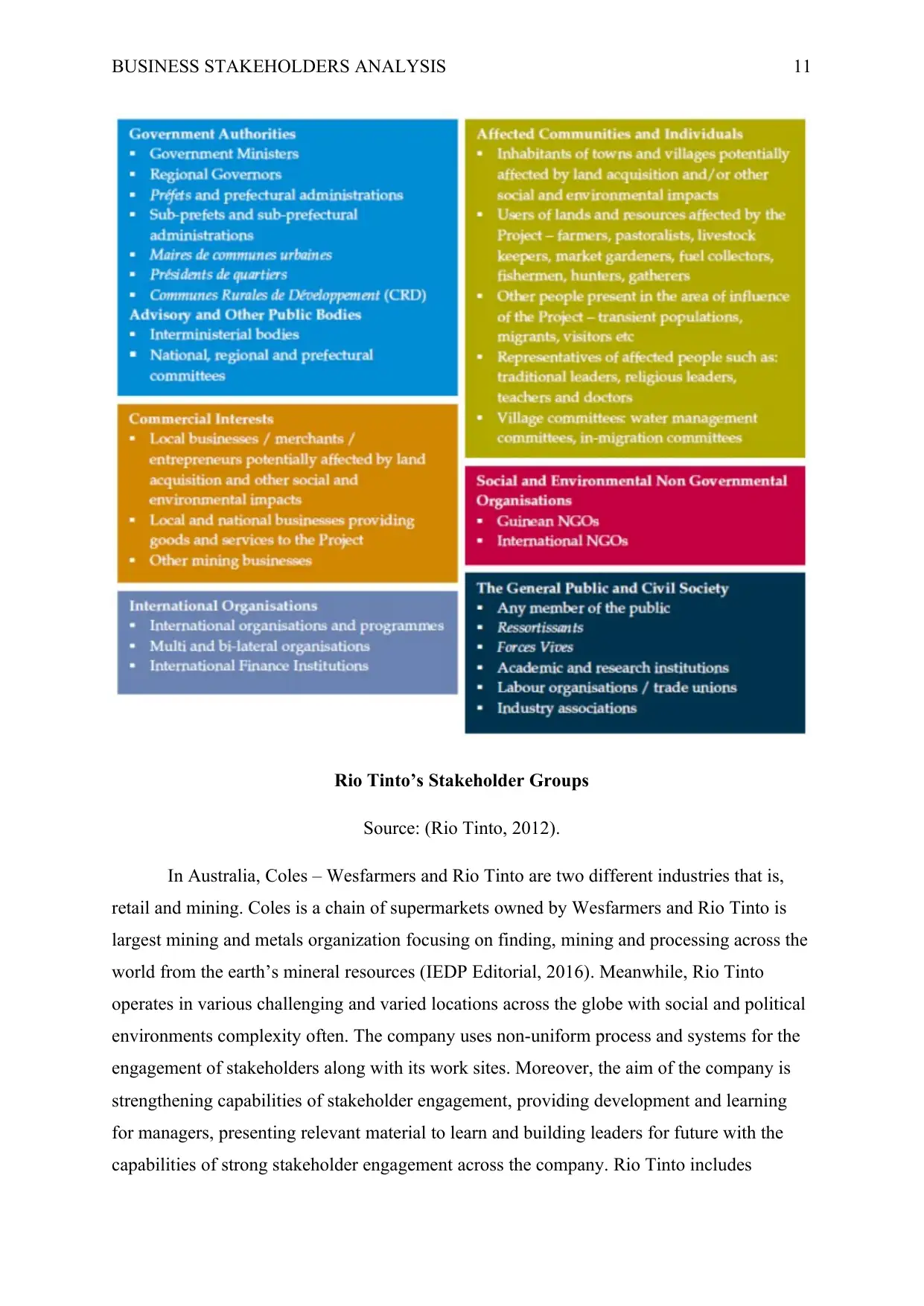
BUSINESS STAKEHOLDERS ANALYSIS 11
Rio Tinto’s Stakeholder Groups
Source: (Rio Tinto, 2012).
In Australia, Coles – Wesfarmers and Rio Tinto are two different industries that is,
retail and mining. Coles is a chain of supermarkets owned by Wesfarmers and Rio Tinto is
largest mining and metals organization focusing on finding, mining and processing across the
world from the earth’s mineral resources (IEDP Editorial, 2016). Meanwhile, Rio Tinto
operates in various challenging and varied locations across the globe with social and political
environments complexity often. The company uses non-uniform process and systems for the
engagement of stakeholders along with its work sites. Moreover, the aim of the company is
strengthening capabilities of stakeholder engagement, providing development and learning
for managers, presenting relevant material to learn and building leaders for future with the
capabilities of strong stakeholder engagement across the company. Rio Tinto includes
Rio Tinto’s Stakeholder Groups
Source: (Rio Tinto, 2012).
In Australia, Coles – Wesfarmers and Rio Tinto are two different industries that is,
retail and mining. Coles is a chain of supermarkets owned by Wesfarmers and Rio Tinto is
largest mining and metals organization focusing on finding, mining and processing across the
world from the earth’s mineral resources (IEDP Editorial, 2016). Meanwhile, Rio Tinto
operates in various challenging and varied locations across the globe with social and political
environments complexity often. The company uses non-uniform process and systems for the
engagement of stakeholders along with its work sites. Moreover, the aim of the company is
strengthening capabilities of stakeholder engagement, providing development and learning
for managers, presenting relevant material to learn and building leaders for future with the
capabilities of strong stakeholder engagement across the company. Rio Tinto includes
⊘ This is a preview!⊘
Do you want full access?
Subscribe today to unlock all pages.

Trusted by 1+ million students worldwide
1 out of 16
Related Documents
Your All-in-One AI-Powered Toolkit for Academic Success.
+13062052269
info@desklib.com
Available 24*7 on WhatsApp / Email
![[object Object]](/_next/static/media/star-bottom.7253800d.svg)
Unlock your academic potential
Copyright © 2020–2025 A2Z Services. All Rights Reserved. Developed and managed by ZUCOL.





